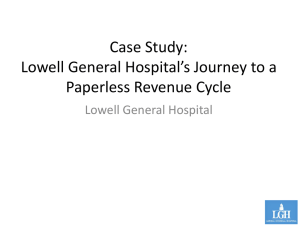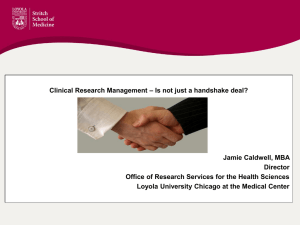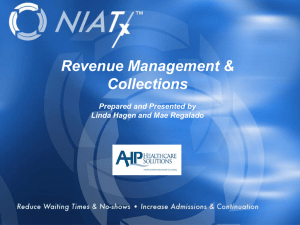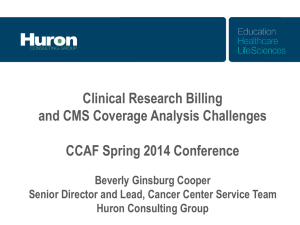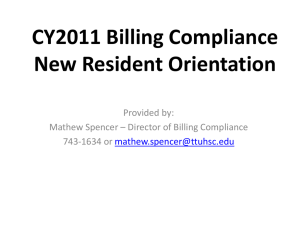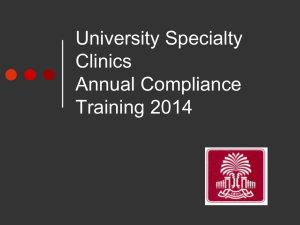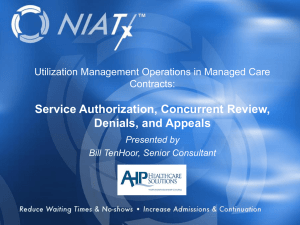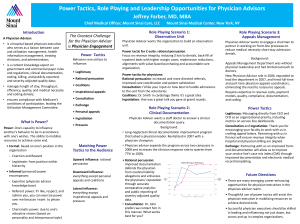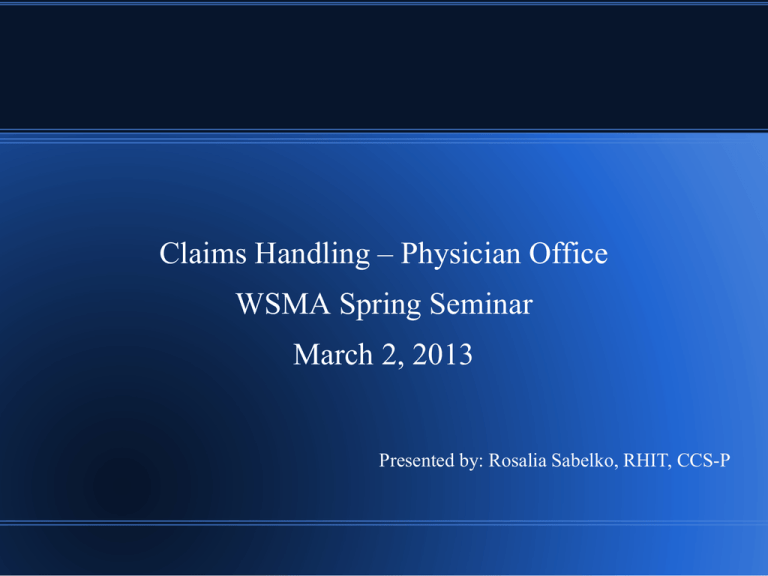
Claims Handling – Physician Office
WSMA Spring Seminar
March 2, 2013
Presented by: Rosalia Sabelko, RHIT, CCS-P
What is Claims Management?
The claims management process in the physician
office is the internal workflow for preparing,
submitting, and collecting claims.
Who is involved in the process?
All members of the physician office team have a role in the claims
management process.
Registration
Clinical Staff
Physicians
Coding
Billing
Collections
Benefits of Claims Management
●
Increased staff efficiency
●
Streamlined claims billing processes
●
Increased number of clean claims submitted
●
Reduced number of claims denied
●
Timely and accurate payment from the health insurer
Elements of Claims Management
Pre-Registration
–
Accurate collection of patient demograhics and health
information
–
Verification of insurance and applicable
deductibles/copays/co-insurance
Patient Check-In
–
Copying patient’s health insurance card
–
Verification of insurance information
Elements of Claims Management
Documentation of Services Provided
–
Patient's history, symptoms, diagnosis and treatment plan
including labs or x-rays ordered
“If it isn’t documented, it wasn’t done”
Elements of Claims Management
Assignment of Diagnosis and Procedure Codes
–
Use of “encounter” or “charge master”
–
Is the content of the current office visit consistent with
the diagnosis and plan?
–
Was a complete physical performed at the subsequent
office visit?
Elements of Claims Management
Patient Check-Out
–
Schedule follow-up
–
Collect co-payment or deductible
–
Special payment arrangements
Elements of Claims Management
Code Verification and Review
–
Use the encounter form to create claim for patient
–
Billing specialists and coders must be familiar with
Medicare guidelines and commercial insurance carrier
guidelines
Elements of Claims Management
Example of Differences between Medicare and
Commercial Payer
Extracorporeal shockwave lithotripsy (ESWL) is performed for a
kidney stone in the right kidney and a kidney stone in the left kidney
–
For Medicare, the removal of both of these stones would be
entered as 50590-50 on the claim
–
A commercial payer may require that this be entered as 2 lines on
the claim with codes
50590-RT and 50590-LT
Resources for Coding Guidelines
http://cms.gov
http://ama-assn.org
http://humana.com/providers/home.asp
http://medica.com
Elements of Claims Management
Claim Generation
–
Codes and fees are entered accurately and a claim is
generated
Claim Review
–
Billing specialists review the claims for accuracy, correct
as needed, and submit to insurers
Elements of Claims Management
Claims Processing, Adjudication, Payment
–
Health insurer should review the claim, approve, and
route payment and a copy of the EOB to the physician
office. Original EOB is routed to patient.
Collections/Claim Follow-up
–
If insurer not processing claim in timely manner,
collections staff follows up with insurer
Elements of Claims Management
Posting Payment
–
Collections staff should verify payment according to
contract and post in accounts receivable
Claim Appeal
–
If collections staff deem payment inappropriate,
investigate and appeal the denial
Documentation for Clean Claims
The patient's chart must have documentation that will
support the level of service or procedure provided.
Proper documentation allows coders to translate
medical documentation (words) into numbers.
Documentation for Clean Claims
CPT and diagnosis codes must accurately reflect
documentation for visit
–
Global fee periods for surgery
–
Modifiers
–
Medical necessity
Examples of Issues with Medical
Necessity
Edit Category
Explanation
Procedure to Procedure
Prevents payment for procedures that are contrary
to the NCCI or procedures billed within a global
period of another procedure.
Procedure to Provider
Looks for procedures performed by specialty; ie.,
Urology billing for cardiac catheterization, or OB/GYN
billing for kidney stone removal.
Procedure to Sex, Age, or Diagnosis Ensures that sex-specific services are not paid
inadvertently; ie., prostate surgery for a female.
Diagnosis to Procedure
Prevents payment of an unwarranted procedure for a
given condition; ie., tonsillectomy for foot pain.
Procedure for Place of Service
Prevents payment for a procedure in an obviously
wrong place of service; ie., hip replacement surgery
in an office setting.
Documentation for Clean Claims
The goal of this process is to pay
the right amount
to the right provider
for the right service
to the right beneficiary.
Denials and Appeals
Denials = revenue delay, revenue loss
Medicare, as well as most commercial insurance
carriers, have tools you can access via websites to
assist with the claims appeals process.
Denials and Appeals
Reasons for Denials
–
Medical necessity
–
Missing or invalid CPT or HCPCS code submitted
–
Incorrect patient identifier information submitted
●
Spelling of name, date of birth, subscriber number missing or invalid, insured group number
missing or invalid
–
Procedure/surgery requires prior authorization or precertification
–
Place of service does not match surgery/procedure performed
–
Claim submitted for non-covered service
Denials and Appeals
Why is an Advance Beneficiary Notice (ABN)
Needed?
–
If Medicare deems a service “not reasonable and medically necessary”, and the
patient decides to proceed with the service, the ABN is used to bill the patient
for the services provided
Denials and Appeals
Documentation Mistakes
–
Physician “short-cuts” in documenting medical necessity
●
Clear to physician; not clear to insurance claims reviewer
●
Claims reviewers look for
Specific terminology
– Descriptions that match insurance policies
–
Claims Reviews
In the health care industry, regulators are employed to
ensure providers are documenting and billing
according to law
–
Office of Inspector General (OIG),
–
Auditors from governmental payers,
–
Auditors from commercial payers,
–
Attorneys
Purpose of Chart Reviews
–
Adherence to clinical protocols
–
Patient adherence with medication regimens
–
Provider compliance with coding and documentation
Claims Reviews
External Chart Reviews
–
Medicare Risk Adjustment (MRA) Audit
–
Health insurer audits
Internal Chart Reviews
–
6-10 charts per physician per year
–
Audit for over coding and under coding
Claims Reviews
Goals for Claims Reviews
–
Quality improvement
–
Identify trends/top procedure codes
●
–
Used for negotiating contracts with insurance carriers
Ensure the office is being paid according to contract
Summary
Professional and diligent efforts of the entire physician
office staff help to ensure a successful claims
management process.
Questions?
rsabelko@westernwisconsinurology.com

